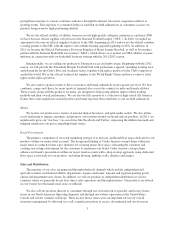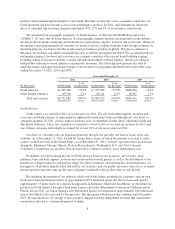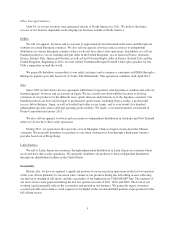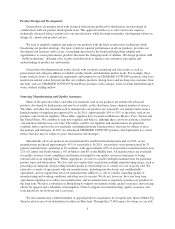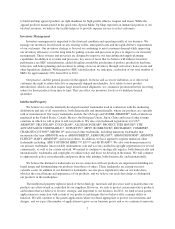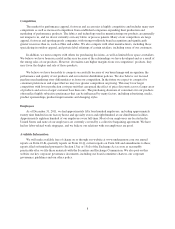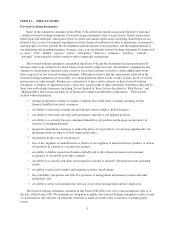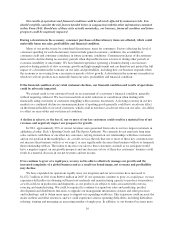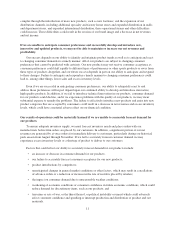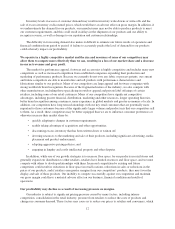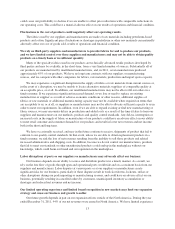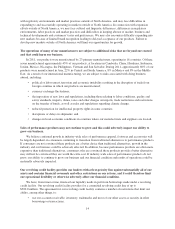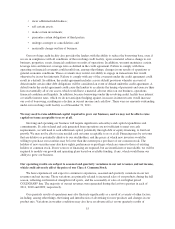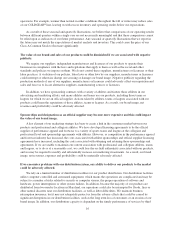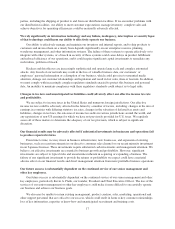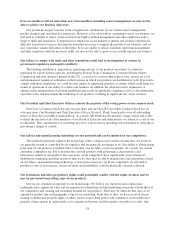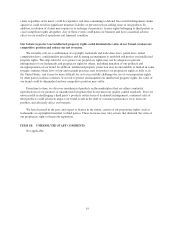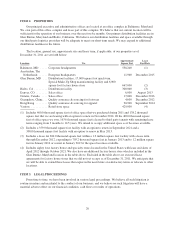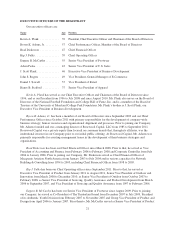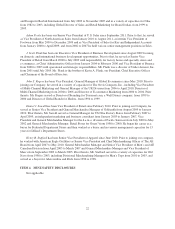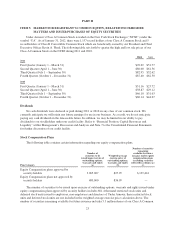Under Armour 2011 Annual Report Download - page 23
Download and view the complete annual report
Please find page 23 of the 2011 Under Armour annual report below. You can navigate through the pages in the report by either clicking on the pages listed below, or by using the keyword search tool below to find specific information within the annual report.could cause our profitability to decline if we are unable to offset price reductions with comparable reductions in
our operating costs. This could have a material adverse effect on our results of operations and financial condition.
Fluctuations in the cost of products could negatively affect our operating results.
The fabrics used by our suppliers and manufacturers are made of raw materials including petroleum-based
products and cotton. Significant price fluctuations or shortages in petroleum or other raw materials can materially
adversely affect our cost of goods sold, results of operations and financial condition.
We rely on third-party suppliers and manufacturers to provide fabrics for and to produce our products,
and we have limited control over these suppliers and manufacturers and may not be able to obtain quality
products on a timely basis or in sufficient quantity.
Many of the specialty fabrics used in our products are technically advanced textile products developed by
third parties and may be available, in the short-term, from a very limited number of sources. Substantially all of
our products are manufactured by unaffiliated manufacturers, and, in 2011, seven manufacturers produced
approximately 45% of our products. We have no long term contracts with our suppliers or manufacturing
sources, and we compete with other companies for fabrics, raw materials, production and import quota capacity.
We may experience a significant disruption in the supply of fabrics or raw materials from current sources or,
in the event of a disruption, we may be unable to locate alternative materials suppliers of comparable quality at
an acceptable price, or at all. In addition, our unaffiliated manufacturers may not be able to fill our orders in a
timely manner. If we experience significant increased demand, or we lose or need to replace an existing
manufacturer or supplier as a result of adverse economic conditions or other reasons, additional supplies of
fabrics or raw materials or additional manufacturing capacity may not be available when required on terms that
are acceptable to us, or at all, or suppliers or manufacturers may not be able to allocate sufficient capacity to us in
order to meet our requirements. In addition, even if we are able to expand existing or find new manufacturing or
fabric sources, we may encounter delays in production and added costs as a result of the time it takes to train our
suppliers and manufacturers on our methods, products and quality control standards. Any delays, interruption or
increased costs in the supply of fabric or manufacture of our products could have an adverse effect on our ability
to meet retail customer and consumer demand for our products and result in lower net revenues and net income
both in the short and long term.
We have occasionally received, and may in the future continue to receive, shipments of product that fail to
conform to our quality control standards. In that event, unless we are able to obtain replacement products in a
timely manner, we risk the loss of net revenues resulting from the inability to sell those products and related
increased administrative and shipping costs. In addition, because we do not control our manufacturers, products
that fail to meet our standards or other unauthorized products could end up in the marketplace without our
knowledge, which could harm our brand and our reputation in the marketplace.
Labor disruptions at ports or our suppliers or manufacturers may adversely affect our business.
Our business depends on our ability to source and distribute products in a timely manner. As a result, we
rely on the free flow of goods through open and operational ports worldwide and on a consistent basis from our
suppliers and manufacturers. Labor disputes at various ports or at our suppliers or manufacturers create
significant risks for our business, particularly if these disputes result in work slowdowns, lockouts, strikes or
other disruptions during our peak importing or manufacturing seasons, and could have an adverse effect on our
business, potentially resulting in cancelled orders by customers, unanticipated inventory accumulation or
shortages and reduced net revenues and net income.
Our limited operating experience and limited brand recognition in new markets may limit our expansion
strategy and cause our business and growth to suffer.
Our future growth depends in part on our expansion efforts outside of the North America. During the year
ended December 31, 2011, 94% of our net revenues were earned in North America. We have limited experience
13


